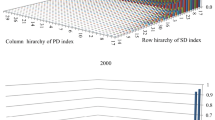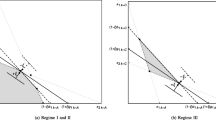Abstract
One of the central debates surrounding the design of the European Union Emissions Trading Scheme is the approach to address carbon leakage concerns. Correctly identifying the economic activities exposed to the risk of carbon leakage represents the first step in mitigating the risk effectively. This paper assesses the robustness of the quantitative assessment criteria used by the European Commission for Phase 3. For example we apply the criteria to data for UK and Germany and compare the results with the Commissions’ assessment conducted at the aggregated EU level. This reveals that sectors’ exposure risk to carbon leakage can vary across different Member States due to differences in production processes, technologies and fuel mix; process emissions; recycling rate differences; product mix differences; sector classification, statistical boundaries, activity allocation differences; and finally difference in data quality. Overall, we find that relative carbon intensity of sectors, measured as cost increase relative to gross value added, provides a robust metric. The analysis also highlights the importance of using high quality and disaggregated data for this assessment.








Similar content being viewed by others
Notes
Emissions leakage is a secondary or spillover effect of carbon pricing, and affects the environmental effectiveness of a unilateral carbon pricing policy. It is usually expressed in percentage terms, for example for EU’s unilateral action, dividing the increased emissions outside the EU by the decrease in emissions within the EU (see IPCC 2007).
The world’s largest \(\hbox {CO}_{2}\) market, covering around 40–45 % of EU emissions.
Directly subject to the \(\hbox {CO}_{2}\) price are some 12,000 installations covered by the scheme, usually belonging to the power iron and steel, cement, pulp and paper, glass, chemicals and refining industries.
The third indicator is a qualitative one, as specified in paragraph 17 of Article 10a.
Standard Industrial Classification is the standard reporting format for industry data. Data is readily available at high resolution disaggregation and can thus enable detailed evidence-based cross-sectoral analysis. The number of manufacturing classes increase from 23 at 2-digit resolution, to 101 at 3-digit resolution and 239 at 4-digit resolution. SIC definitions are end-product driven, however, and often do not capture distinctions between manufacturing processes and carbon intensities, for example that between BOF and EAF processes in steel. For sectors where differentiation between processes is key to competitiveness and leakage impacts, explicitly looking at examination of the production or value chain is required. In addition, some sectors are covered under different Classification (SIC) codes (e.g. Mineral Wool is defined under 26.14 for Glass Wool and 26.82 for Rock Wool).
This is estimated by BERR based on annual company reports of fuel consumption to the Annual Business Inquiry collected by the Office for National Statistics, using average price data and then scaled to the aggregate volumes reported for 12-sector figures published in Detailed UK Energy Statistics (DUKES) by BERR (2006).
The UK ONS states that “Gross value added (GVA) represents the amount that individual businesses, industries or sectors contribute to the economy. Broadly, this is measured by the income generated by the business, industry or sector less their intermediate consumption of goods and services used up in order to produce their output. GVA consists of labour costs (e.g. wages and salaries) and an operating surplus (or loss). The latter is a good approximation to profits, and out of which the cost of capital investment, financial charges and dividends to shareholders are met.” (http://www.statistics.gov.uk/abi/variable_info.asp).
For some subsectors, trade data was verified during the industry consultation period.
Here, GVA and GDP are used interchangeably. According to UK Office of National Statistics, “GVA is used in the estimation of Gross Domestic Product (GDP). GDP is a key indicator of the state of the whole economy. In the UK, three theoretical approaches are used to estimate GDP: ‘production’, ‘income’ and ‘expenditure’. When using the production or income approaches, the contribution to the economy of each industry or sector is measured using GVA.
Under the Commission’s assessment, trade intensity for sector i is defined as the sum of the value of EU-27 exports to outside the EU-27 and the value of imports from outside the EU-27 for sector i, divided by the sum of total annual turnover of sector i plus the value of imports from outside the EU-27 (see Juergens et al. 2013). As shown in Equation 4, the definition used in this paper, as it considers both the EU imports and Non-EU imports in the denominator.
References
Abrell J, Faye AN, Zachmann G (2011) Assessing the impact of the EU ETS using firm level data. Bruegel, Brussels. http://www.beta-umr7522.fr/productions/publications/2011/2011-15.pdf
BERR (2006) Detailed UK energy statistics (DUKES). http://www.dti.gov.uk/energy/statistics/source/electricity/page18527.html
BERR (2007) Energy statistics publication, UK energy consumption, energy consumption tables: industrial energy consumption tables, URN No: 07/455. http://www.dti.gov.uk/energy/statistics/publications/ecuk/industrial/page18171.html
Branger F, Quirion P (2013) Understanding the impacts and limitations of the current instrument mix in detail: industrial sector. Cecilia 2050 Optimal EU, Climate Policy FP7 Project
Carbon Trust, The (2004) The European emissions trading scheme: implications for inducstrial competitiveness, The Carbon Trust
Carbon Trust, The (2005) The UK climate change programme: potential evolution for the business and public sector, The Carbon Trust
Chernyavs’ka L, Gulli F (2008) Marginal CO2 pass-through under imperfect competition in power markets. Ecol Econ 68(1–2):408–421
Citigroup (2008) Carbon pollution reduction scheme—impacts reviewed for ASX100 companies and more. Thematic Investing Focus, Australia, 22 July 2008
Clò S (2010) Grandfathering, auctioning and carbon leakage: assessing the inconsistencies of the new ETS directive. Energy Policy 38(5):2420–2430
Costantini V, Mazzanti M (2012) On the green and innovative side of trade competitiveness? The impact of environmental policies and innovation on EU exports. Res Policy 41(1):132–153
Cummins M, O’Shea P, Lyons K (2012) A unified analysis of emissions and energy market interactions across the EU. Working paper
de Bruyn S, Markowska A, Nelissen D (2010a) Will the energy intensive industry profit from the EU ETS under Phase 3? Delft: CE Delft, 2010
de Bruyn S, Markowska A, Femke D, Bles M (2010b) Does the energy intensive industry obtain windfall profits through the eu ets? An econometric analysis for products from the refineries, iron and steel and chemical sectors. CE Delft report
De Bruyn S, Nelissen D, Koopman M (2013) Impact of recent developments in theEU ETS on the list of sectors deemed to be exposed to carbon leakage. Technical report, CE Delft
DEFRA (2007) Compliance and results, analysis of the UK results. Accessed from http://www.defra.gov.uk/environment/climatechange/trading/eu/operators/compliance.htm
Ellerman AD, Convery FJ, de Perthuis C (2010) Pricing carbon: the European union emissions trading scheme. Cambridge University Press, Cambridge
European Commission (2007) Second report of the high level group on competitiveness, energy and the environment contributing to an integrated approach on competitiveness, energy and environment policies http://ec.europa.eu/enterprise/environment/hlg/doc_06/second_report_30_10_06.pdf
European Parliament and the Council of the EU (2009) Directive 2009/29/EC of the European parliament and of the council of 23 April 2009 amending directive 2003/87/EC so as to improve and extend the greenhouse gas emission allowance trading scheme of the community. Off J Eur Union I140:63–87
Eurostat. National accounts: tables and figures [online] (2013) http://epp.eurostat.ec.europa.eu/statistics_explained/index.php/National_accounts_main_GDP_aggregates_and_related_indicators#Further_Eurostat_information [cited November 2013]
Graichen V, Schumacher K, Matthes F, Mohr L, Duscha V, Schleich J, Diek- mann J (2008) Impacts of the EU emissions trading scheme on the industrial competitiveness in Germany. Technical Report 3707 41 501, Environmental Research of the Federal Ministry of the Environment, Nature Conservation and Nuclear Safety, Berlin, Germany
Grubb M, Neuhoff K (2006) Allocation and competitiveness in the EU emissions trading scheme: policy overview. Clim Policy 6(1):7–30. http://www.tandfonline.com/doi/abs/10.1080/14693062.2006.9685586
Hepburn Grubb, Neuhoff Matthes, Tse (2006) Auctioning of EU ETS Phase II allowances: how and why? Clim Policy 6(1):137–160
Hourcade et al (2007) Differentiation and dynamics of EU ETS industrial competitiveness impacts. Climate Strategies Report, Climate Strategies
IPCC (2007) Climate change: mitigation of climate change. In: Metz ORDB, Bosch PR,Dave R, Meyer LA (eds) Contribution of working group III to the fourth assessment report of the intergovernmental panel on climate change. Cambridge University Press, Cambridge
Juergens I, Barreiro-Hurlé J, Vasa A (2013) Identifying carbon leakage sectors in the EU ETS and implications of results. Clim Policy 13(1):89–109. http://www.tandfonline.com/doi/abs/10.1080/14693062.2011.649590
Lacombe R (2008) Economic impact of the european union emission trading scheme: evidence from the rening sector. Masters Thesis, Ecole Polytechnique, Paris
Lecourt S, Pallière C, Sartor OJ (2013) The impact of emissions-performance benchmarking on free allocations in EU ETS phase 3. http://hal.archives-ouvertes.fr/hal-00809096
Lise W, Sijm J, Hobbs BF (2010) The impact of the EU ETS on prices, profits and emissions in the power sector: simulation Results with the COMPETES EU20 model. Environ Resour Econ 47:23–44
Martin R, Muûls M, Wagner UJ (2010) Still time to reclaim the European union emissions trading system for the European tax payer. Policy Brief, Centre for Economic Performance, London School of Economics
Martin R, Muûls M, DePreux L, Wagner U (2013) Industrycompensationunder the risk of relocation: a firm-level analysis of the EU emissions trading scheme. NBER working paper. http://papers.ssrn.com/sol3/papers.cfm?abstract_id=2033683
Maxwell D (2011) Hot air: the carbon price floor in the UK London: IPPR; McCabe, J 2011. “£7bn windfall for UK utilities from carbon price floor” Environmental, Finance, 28 June
Morgenstern RD, Ho M, Shih JS, Zhang X (2006) The near term impacts of carbon mitigation policies on manufacturing industries. Energy Policy 32(16):1825–1841
Neuhoff K, Keats K, Sato M (2006) Allocation, incentives and distortion: the impact of EU ETS emission allowance allocations to the electricity sector. Clim Policy 6(1)
Oberndorfer U, Alexeeva-Talebi V, Löschel A (2010) Understanding the competitiveness implications of future phases of EU ETS on the industrial sectors, ZEW Discussion Paper 10–044. ZEW, Mannheim
Sandbag (2011) Carbon fat cats 2011: the companies profiting from the EU Emissions Trading Scheme. Report, Sandbag Climate Campaign. http://www.sandbag.org.uk/site_media/pdfs/reports/Sandbag_2011-06_fatcats.pdf
Point Carbon (2008) EU ETS Phase II—the potential and scale of windfall profits in the power sector: a report for WWF by point carbon advisory services
Quirion P (2011) Les Quotas Echangeables D’emissions de Gaza EffetdeSerre:Elements D’analyseE ìconomique. Me ì moire D’habilitation a‘ Diriger Des Recherches. EHESS
Reinaud J (2008) Issues behind competitiveness and carbon leakage: focus on heavy industry. EA Information Paper. Paris, France: International, Energy, 2008
Sartor O (2012) Carbon leakage in the primary aluminium sector: what evidence after 6.5 years of the EU ETS? Working paper 2012–12, CDC Climat Research
Smale R, Hartley M, Hepburn C, Ward J, Grubb M (2006) The impact of \(CO_{2}\) emissions trading on firm profits and market prices. Clim Policy 6(1):31–48
Tang X (2008) An economic analysis of North American pulp and paper markets, and a competitiveness study of the Canadian pulp and paper products. Ph.D thesis, University of Toronto
USA EPA (2004) Unit conversion, emissions factors, and other reference data. http://www.epa.gov/appdstar/pdf/brochure.pdf
UNFCCC (2006) National emissions reported to the UNFCCC. http://dataservice.eea.europa.eu/dataservice/metadetails.asp?id=991
UK Office of National Statistics (2004) Trade in Goods Industry BOP MQ10. http://www.statistics.gov.uk/statbase/tsdtables1.asp?vlnk=mq10
UK Office of National Statistics (2006) Annual business inquiry reports. http://www.statistics.gov.uk/abi/
Wang X, Li, J, Zhang Y (2010) An analysis on the short-term sectoral competitiveness impact of carbon tax in china. IDDRI working paper
World Resource Institute (2008) Leveling the carbon playing field: international competition and U.S. climate policy design. http://www.wri.org/publication/leveling-the-carbon-playing-field
Zachmann G, von Hirschhausen C (2008) First evidence of asymmetric cost pass-through of EU emissions allowances: examining wholesale electricity prices in Germany. Econ Lett 99(3):465–469
Author information
Authors and Affiliations
Corresponding author
Rights and permissions
About this article
Cite this article
Sato, M., Neuhoff, K., Graichen, V. et al. Sectors Under Scrutiny: Evaluation of Indicators to Assess the Risk of Carbon Leakage in the UK and Germany. Environ Resource Econ 60, 99–124 (2015). https://doi.org/10.1007/s10640-014-9759-y
Accepted:
Published:
Issue Date:
DOI: https://doi.org/10.1007/s10640-014-9759-y




